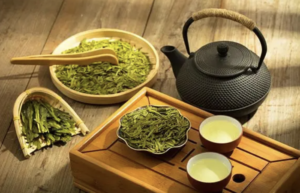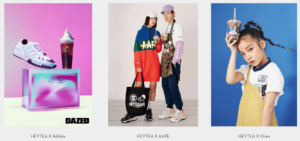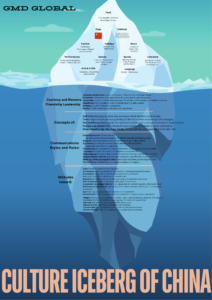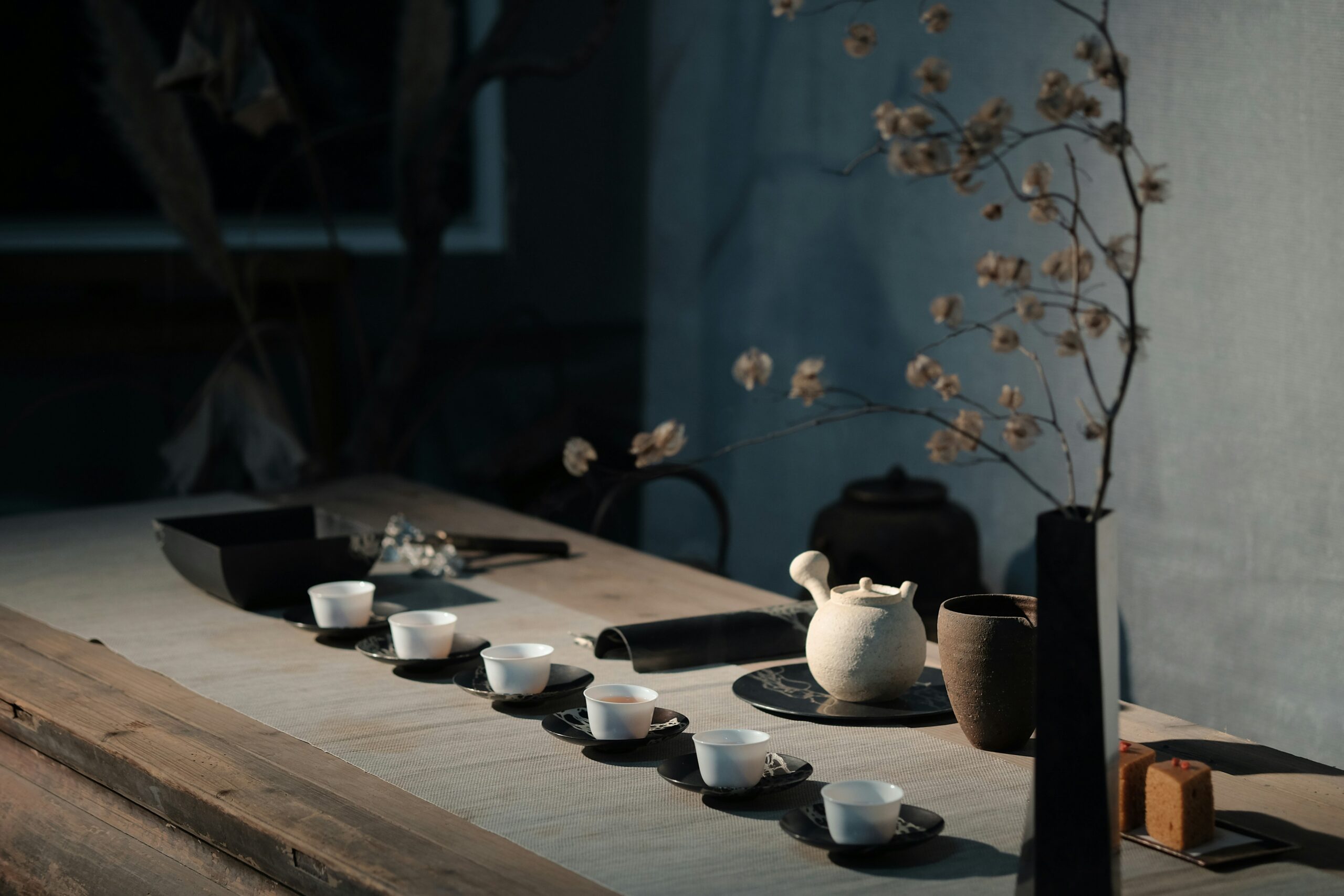“Brewing Change: The Epochal Journey of Tea Culture and China —From Ancient Roots to Global Influence”
This blog explores the transformative timeline of Chinese tea culture through various eras. First, we delve into the Ancient Tea Era, highlighting the establishment of tea culture during the Tang Dynasty and its sophisticated rituals rooted in Taoist and Confucian philosophies. Then, we transition to the Milk Tea Era, where modern adaptations like bubble tea revolutionized the market between 2000 to 2010, becoming a global phenomenon. Lastly, we arrive at the Modern Era, where HEYTEA, as a well-known brand, innovative tea beverages and strategic marketing have propelled traditional tea culture to international acclaim. This journey not only showcases the evolution of tea but also reflects the dynamic spirit of Chinese culture and beliefs.
ANCIENT TEA ERA

In China, tea is much more than just a beverage; it’s a significant element of the culture, steeped in history that dates back to the Shang dynasty around 1500 BC. By the time of the Tang Dynasty (618-907 AD), tea culture was well-established, largely thanks to “The Classic of Tea” by Lu Yu, which detailed sophisticated methods of tea cultivation, production, and consumption. Today, China leads as the world’s largest tea producer, accounting for approximately 42% of the global tea production with around 2.4 million metric tons produced annually. Each region of China contributes its unique flavor to the culture of tea; for example, Hangzhou is renowned for its Green tea, Fujian for its Oolong, and Yunnan for its Pu’er. These teas are not only consumed domestically but are also significant exports, with China exporting around 360,000 metric tons of tea in 2019. This rich tradition is carried on through the Chinese tea ceremony, or “Gongfu Cha,” a practice that emphasizes the art and aesthetic of tea preparation, particularly in Fujian and Guangdong. The enduring popularity of tea, including modern adaptations like bubble tea, which emerged from Taiwan in the 1980s and quickly captivated Mainland China, illustrates the dynamic and adaptive spirit of Chinese tea culture.
Tea rituals in ancient China were a sophisticated, highly ceremonial process that was intricately linked to the cultural and philosophical fabric of society. The ritual stressed purity and preparation, beginning with the careful selection of excellent tea leaves and proper implements, which were often made of porcelain or clay. This involved ceremonially washing the utensils, which represented purity and attention. Brewing the tea was a careful operation, with water prepared to the appropriate temperature and the leaves steeped for precisely the right amount of time to optimize flavor. Serving tea followed a set sequence and protocol, usually beginning with the most esteemed guest and using both hands as a gesture of respect. Drinking the tea was also meditative, allowing participants to absorb the aroma and taste gently, creating a time of calm and thought. Following the tea, talks frequently proceeded, often touching on philosophical or lyrical issues, which increased the attendees’ social and intellectual participation. These ceremonies emphasized the balance between nature and humanity, reflecting Taoist and Confucian beliefs, and made tea drinking a powerful expression of cultural identity and philosophical thought.
MILK TEA ERA
The milk tea industry in China has evolved from traditional tea practices to include various modern iterations, including bubble tea, which became a cultural phenomenon both domestically and globally. The introduction of tapioca pearls into sweetened iced tea in Taiwan sparked a new trend that spread rapidly across Asia and later worldwide, becoming a staple in the global beverage market. By 2019, the global bubble tea market was valued at approximately $2.4 billion and is expected to grow to $4.3 billion by 2027, reflecting an annual growth rate of over 7.5%.
MODERN ERA of HEY TEA
In the 21st century, the Chinese tea drink market has undergone significant transformation with the rise of new-style tea beverages. Founded in 2012, HEYTEA quickly became popular among young consumers through innovative tea preparation techniques and marketing strategies. Since its founding, HEYTEA has expanded rapidly. By 2020, HEYTEA operated over 500 stores across China and received more than $500 million in funding from major investors, highlighting its significant impact on the market.HEYTEA has introduced a variety of drinks that blend traditional and modern tastes, such as cheese-topped teas and fruit tea series, successfully merging traditional tea culture with a modern lifestyle using social media strategies to engage with the youth.
With its growth, HEYTEA has begun to expand internationally, recently opening a new store in Paris, symbolizing the global reach of China’s new-style tea culture. By March 2024, HEYTEA have operated 3400+ stores in over 300 cities all over the world and served 100,000,000+ consumers globally.The collaboration between HEYTEA and Fendi, launched in May 2023, has created a significant buzz, particularly among younger consumers in China. This partnership marked a unique blending of high fashion and popular beverage culture, highlighting both brands’ innovative approaches to capturing the interest of the Gen Z market.

The collaboration was strategically timed to coincide with Fendi’s “Hand in Hand” exhibition in Beijing, enhancing both brands’ visibility and appeal. As part of the collaboration, HEYTEA introduced a new fruit tea, which features a blend of passion fruit, orange, and mango flavors, reflecting Fendi’s iconic color schemes. This special edition tea proved extremely popular, selling out on its first day of release in several locations, including Shanghai, and was priced at CNY 19 (approximately USD 2.70) per cup.
HEYTEA’s dramatic rise can largely be attributed to its innovative approach to traditional products and astute brand positioning. The introduction of unique offerings like cheese tea, which blends traditional tea with creamy cheese foam, set HEYTEA apart as a trendsetter in the beverage industry. This innovation captured the young consumer market seeking new culinary experiences. Coupled with visually driven and interactive marketing strategies, HEYTEA established itself as a premium brand that harmonizes traditional tea culture with a modern twist, appealing particularly to the youth who cherish both heritage and innovation.

As we explore the dynamic evolution of tea from its traditional roots to contemporary trends, it’s crucial to understand the broader cultural context in which these transformations occur. The ‘Culture Iceberg of China’ illustrates how deep-seated cultural elements—ranging from traditional beliefs and communication styles to values and attitudes towards relationships and leadership—inform and influence all aspects of Chinese life, including its rich tea culture. This framework helps us see beyond the visible customs to the underlying values that shape the unique tea traditions and innovations in China, reflecting a complex interplay between the visible and invisible aspects of culture.”
The concept of the cultural iceberg was coined in 1976 by Edward T. Hall, who suggested that culture is analogous to an iceberg in that only about 10% of the iceberg is visible at any given time and that a large part of it is hidden deep beneath the surface.

In the grand tapestry of tea’s evolution, from the ancient brews of China to the innovative concoctions of today like HEYTEA, we witness a vivid illustration of the ‘Culture Iceberg of China’. This conceptual framework reveals how visible elements such as the tea rituals and festivals only represent the tip of the iceberg. Below the surface, a vast array of deep cultural currents—values, beliefs, communication styles, and attitudes—powerfully shape and influence these traditions. As demonstrated by the adaptation of traditional tea into modern favorites that captivate global audiences, these underlying cultural dimensions dictate the dynamics of innovation and market trends. Understanding this cultural iceberg is crucial for appreciating the full context of China’s tea culture evolution, offering insights into how deeply ingrained cultural attributes can drive successful global expansion and adaptation. The journey of tea, enriched by this cultural understanding, continues to be a compelling narrative of heritage melding with modernity, inviting us all to explore and appreciate the profound depths of Chinese cultural influence.



